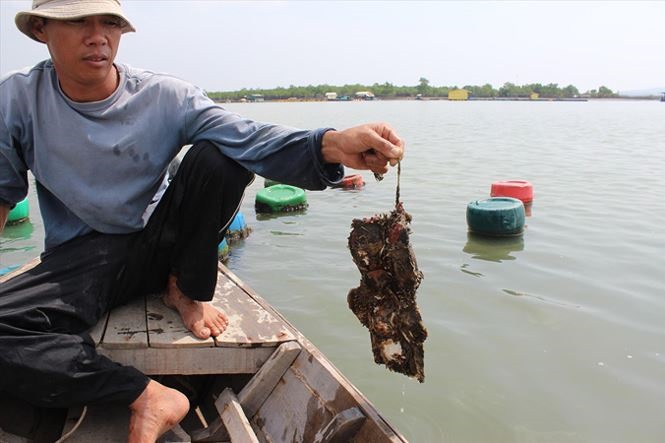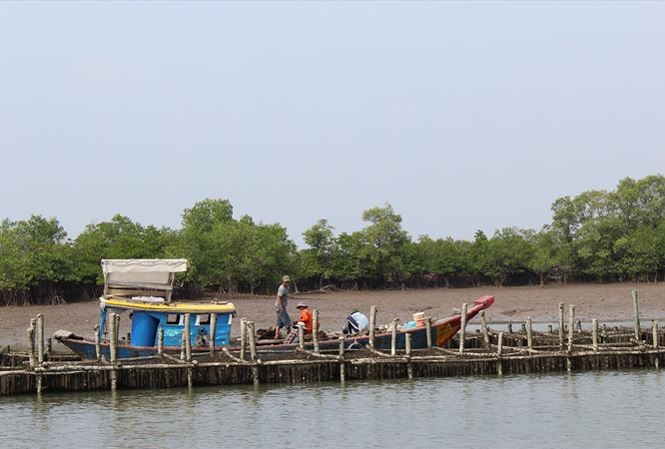 Society
Society

Oysters have brought good life for people in Long Sơn Commune, Vũng Tàu City, but they use fiber cement roofing sheet to make cages thus local authorities concerned that toxic material would affect the environment and consumers’ health.
 |
| Trần Văn Ninh holds a fiber cement sheet which is used for oysters to cling to live. — Photo tienphong.vn |
BÀ RỊA-VŨNG TÀU — Oysters are said to be a natural aphrodisiac and if you are really lucky, you might open the shell to find a precious pearl.
But now environmentalists are worried those who farm this popular seafood in Vũng Tàu City’s Long Sơn Commune could be causing harm to both rivers and even people’s health.
This is because the material used to make oyster cages is made from fiber cement which, when disposed of in the water, carries a risk.
The cement sheets are perfect for farmers to use as the oysters stick to them and they are resistant to water – but local authorities are concerned because the material is toxic.
Trần Văn Ninh, lives in Phước Hòa Commune, Tân Thành District in the southern province of Bà Rịa-Vũng Tàu, has a large oyster farm in the Chà Và River.
After each oyster harvest season, he throws about 6,000 sheets of fiber cement overboard.
Ninh said that no local farmers transported the sheets back to the shore.
To discharge the fibro-cement sheets, Ninh simply throws them in deep water areas even though he is aware of the risks.
"Local authorities told us about the toxicity of fibro cement and that it can pollute the water,” Ninh said.
“But now we haven’t found any alternative materials so we still resort to fibro cement roofing sheets to raise oysters."
Nguyễn Văn Lịch used floating plastic cans to spread fiber cement roofs, which is cut into pieces of about 40sq.cm. It is the place for oysters to cling to live.
"Oysters adhere to the pile, they are about 10 days old and as tiny as sesame seeds, only people specialising in the work like us can distinguish,” said Lịch.
“Whey they are about three months old, they are as big as half a finger and have a relatively hard shell, the farmer moves the oysters into fibro cement sheets to ensure the density for oysters to grow.”
 |
| A frame to raise oysters is on the Mỏ Nhát River. — Photo tienphong.vn |
Loose management
According to the Long Sơn Commune People’s Committee, there are nearly 600 oyster farming households in the commune with an area of about 90ha.
More than 80 per cent of the farmers use fiber cement roofing sheets as a substrate, with about 300,000 pieces of sheet are used each season.
After harvest season, which usually lasts about eight months, most of the fibro-cement sheets are dumped into the river.
Bùi Đức Bình, deputy chairman of the Long Sơn Commune People’s Committee, told the Tiền Phong (Vanguard) newspaper that since 2008, local residents use the sheets to raise oysters without any concern about to water pollution or consumer health.
According to the provincial Department of Fisheries, the dumping of fibro-concrete sheets is the cause of river-bed sedimentation, which changes the flow, causes environmental pollution and direct impacts on water resources for aquaculture, affects the aquaculture production in the area in recent years.
The Centre for Environmental Technology under the Việt Nam Institute of Nature and Environment said that fiber cement roofing sheets immersed in water will create sulfur and some other toxic chemicals, polluting the water source, affecting the ecological environment of aquatic and marine species.
Provincial authorities encourage people to use other materials such as wood and oyster shell to substitute fibro cement.
Fiber sheet is made of cement, silicate mineral fiber and asbestos powder, which is potentially harmful to the environment as well as harmful to human health, said the World Health Organisation (WHO) said. It also causes human diseases when exposed to these toxins through the respiratory and gastrointestinal tract from asbestos-contaminated water.
Tested safe
Trần Văn Cường, director of the provincial Department of Agriculture and Rural Development, said, “We have tested oyster samples and they do not manifest any negative signs. But, scientifically, fibro-cement sheets are harmful, so we have advised them not to use these materials as oyster feeders".
Trần Văn Ký, from the Việt Nam Scientific Association of Food Safety, said fiber sheets had asbestos, a substance that has been warned by the International Agency for Research on Cancer (IARC) as a carcinogen.
They can penetrate the respiratory tract, digestive tract due to polluted water and cause some lung and larynx cancer. Incubation period usually lasts 20-30 years, so the first phase is difficult to be recognised. — VNS
Pearls of wisdom Oysters are meatier in months that have “r” in their names; Oysters have the ability to change their sex; Oysters help waterways by eating algae; The same type of oyster tastes different depending on where it was raised. Oysters are said to help people lose weight and sharpen their memory. |